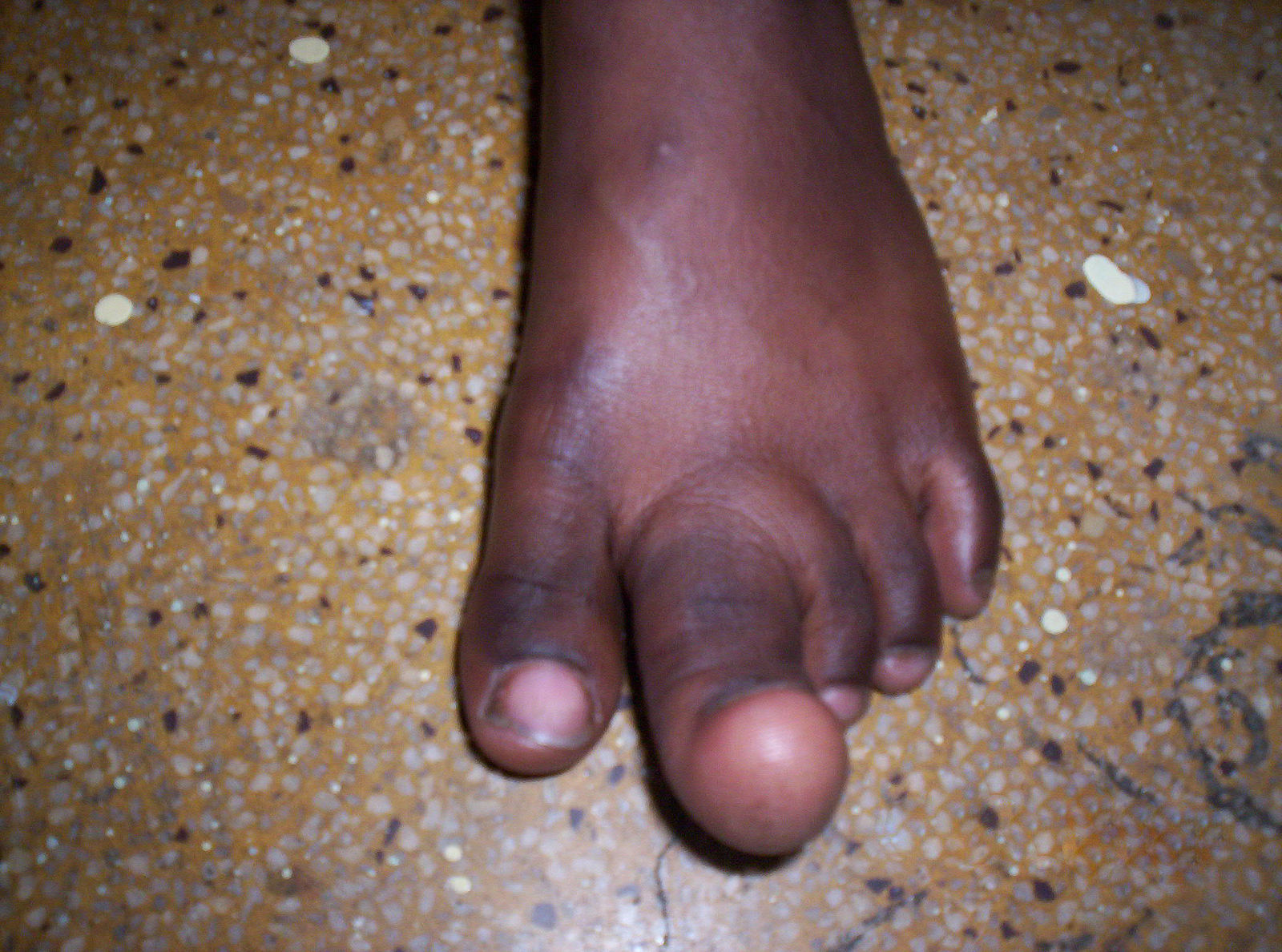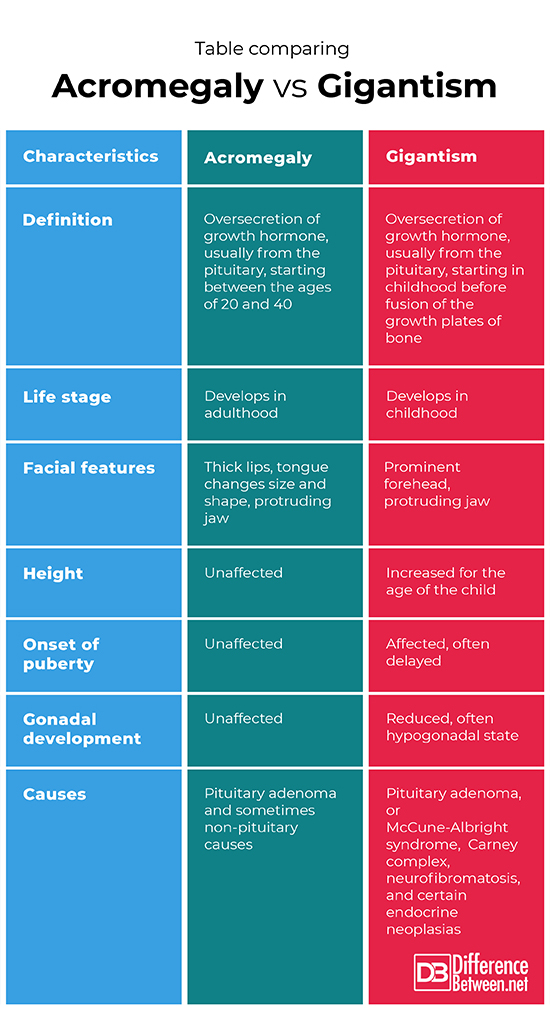Difference between Acromegaly and Gigantism
Acromegaly is oversecretion of growth hormone which begins in adulthood. Gigantism is oversecretion of growth hormone which begins in childhood.
What is Acromegaly?
Definition of Acromegaly:
Acromegaly is the oversecretion of growth hormone from the pituitary gland starting at some time between the ages of 20 and 40 years.
Symptoms of Acromegaly:
The first symptoms are changes in the face, with a coarse look appearing. The feet and hands also swell up. Additional changes in appearance include the development of coarse body hair, and darkened thick skin. Glands of the body increase in size and sweat production increases. The increase in sweat sometimes leads to bad body odor. The jaw also sticks out and tongue may change shape and size. Nerve problems can develop as well.
Diagnosis and causes of Acromegaly:
Acromegaly can be diagnosed by measuring and noticing high levels of growth hormones in blood plasma, and by CT or MRI scans. These scans may show a pituitary tumor present causing the oversecretion. The condition is caused by a hypersecretion of growth hormone that begins in adulthood after the epiphyses are closed. It can be the result of a non-cancerous pituitary tumor or non-pituitary gland tumor in a different region of the brain, in the lungs or pancreas.
Complications involved in Acromegaly:
One of the big complications from having acromegaly is the development of cardiomyopathy, in which the heart enlarges; this then causes problems with the heart function. There can also be increasing problems with the respiratory system and with both lipid and glucose metabolism.
Treatment of Acromegaly:
Surgery in which the tumor is removed is a possible treatment option, radiation therapy may also help. Sometimes medication such as ocreotide can be used to reduce the amount of growth hormone that is being secreted, other medication such as pegvisomant can be used which actually blocks receptors for the hormone. This latter medication then stops the effects of the hormone.
What is Gigantism?
Definition of Gigantism:
Gigantism is the disorder in which excess amounts of growth hormone are secreted from the pituitary gland during a person’s childhood. It occurs before the epiphyseal (growth) plates of the bones have come together and fused.
Symptoms of Gigantism:
There is an unusual growth of muscles, organs, and bones so that a child is bigger, including taller than usual, for their developmental age. There can be symptoms such as blurred vision, delayed start of pubescent changes, double vision, very prominent forehead and jaw, increased sweat production, and large hands and feet. Patients may also feel very tired and their facial features may thicken.
Diagnosis and Causes of Gigantism:
The condition may be diagnosed in a child from a blood test where levels of growth hormone and insulin-like growth factor (IGF-1) are noted to be elevated. An MRI scan or CT scan can show if there is a pituitary adenoma (tumor) present. It is often caused by this benign non-cancerous tumor of the pituitary gland causing oversecretion of the growth hormone. Certain syndromes can also cause the condition, including McCune-Albright syndrome, and Carney complex. Neurofibromatosis and certain endocrine neoplasias can also cause the disorder.
Complications in Gigantism:
Treatment of the condition can lead to metabolic problems including with glucose and lipid metabolism. If not treated the heart can enlarge leading to cardiovascular problems later in life.
Treatment of Gigantism:
Gigantism is often treated by using medicine that helps reduce the overproduction of the growth hormone or blocks the receptors to which the hormone binds. The drug pegvisomant is sometimes used, as well as radiation therapy.
Difference between Acromegaly and Gigantism?
-
Definition
The acromegaly is a disorder in which there is an excess of growth hormone secreted beginning sometime between ages 20 to 40. The gigantism is a disorder in which there is which there is an excess of growth hormone secreted during childhood.
-
Life stage
Acromegaly develops during early to middle adulthood. Gigantism always develops during childhood before the bones’ growth plates have fused.
-
Facial features
In acromegaly, the tongue often changes size and shape, the jaw also protrudes and the lips thicken. In gigantism the jaw becomes prominent and the forehead protrudes.
-
Height
A person with acromegaly does not experience an increase in height because the condition starts in adulthood. A person with gigantism does have increased height because they are children who are still growing.
-
Onset of puberty
Acromegaly develops after puberty and during adulthood so the onset is unaffected. Gigantism develops before puberty and therefore can cause a delay in the onset of puberty.
-
Gonadal development
The gonads (reproductive organs) are not affected by acromegaly since the person is an adult when the condition starts. The gonads are affected though in gigantism since the person is a child when the problem begins.
-
Causes
Acromegaly is caused by a noncancerous pituitary tumor or non-pituitary tumor of the lungs or other parts of the brain. Gigantism is caused by a noncancerous pituitary tumor, McCune-Albright syndrome, Carney complex, neurofibromatosis and also certain endocrine neoplasias.
Table comparing Acromegaly Vs. Gigantism
Summary of Acromegaly Vs. Gigantism
- Both acromegaly and gigantism are conditions in which there is too much growth hormone that is secreted.
- Acromegaly is a disorder that develops in adulthood and thus does not affect gonadal development.
- Gigantism is a disorder that develops in childhood before the growth plates of bones have fused and also affects puberty.
- Both conditions can be treated with medicine and possibly surgery to remove a tumor if that is the cause.
- Difference Between Rumination and Regurgitation - June 13, 2024
- Difference Between Pyelectasis and Hydronephrosis - June 4, 2024
- Difference Between Cellulitis and Erysipelas - June 1, 2024
Search DifferenceBetween.net :
Leave a Response
References :
[0]Chapman, Ian M. “Gigantism and Acromegaly”. Merckmanuals. Merck & Co., 2018, https://www.merckmanuals.com/professional/endocrine-and-metabolic-disorders/pituitary-disorders/gigantism-and-acromegaly
[1]Giustina, A., et al. "Diagnosis and treatment of acromegaly complications." Journal of endocrinological investigation 26.12 (2003): 1242-1247.
[2]Pivonello, Rosario, et al. "Complications of acromegaly: cardiovascular, respiratory and metabolic comorbidities." Pituitary 20.1 (2017): 46-62.
[3]Image credit: https://en.wikipedia.org/wiki/File:Local_gigantism_toe.jpg
[4]Image credit: https://commons.wikimedia.org/wiki/File:Acromegaly_facial_features.JPEG



